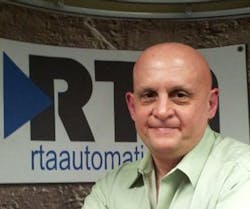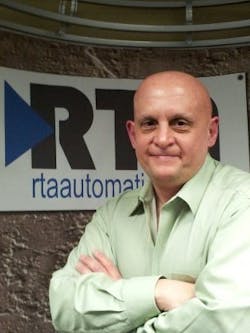Seven ways older automation experts can help the industry
I honestly can’t tell you when it happened. I wasn’t the new kid on the block but I wasn’t one of the old guys either — or at least I never thought of myself as one of them. But somehow along the way it happened.
I looked in the bathroom mirror and there, staring back at me, was a Gray Beard. And for a minute I didn’t recognize myself. When did I become a Gray Beard?
Now if you haven’t been around the military development centers at places like Raytheon or Northrup Grumman or Sperry Rand you might not know what a Grey Beard is. But the people in those places know them. They know them well.
Gray Beards are the guys that remember. They remember the projects that went well, the projects that went bad and they remember the who, the what, and the why. They know what’s been tried in the past and what worked and what failed. They can tell you how the organization evolved and why. Then can recollect what that general said one time and the four-month fire drill that it kicked off.
They’re the institutional memory of a place and they’re revered. Whenever there is an important project meeting, an important decision to make or a product strategy to select, they always bring in the Gray Beard. He strokes his beard — it’s long and gray by the way —– and he thinks and he ponders and then he looks up. And when he looks up everyone holds their collective breath.
He’ll begin with a story — it’s always a he. At Sperry it might be about a gyroscope they built for the Navy in WW1. At Raytheon it might be the story of radar or microwave ovens. It’s an old story but everyone will listen to find out what, how, and why this story provides some insight into the decision on the table.
Gray Beards are really prominent in the huge military engineering development organizations but we have those gray beards in automation too. They’re usually a little harder to pick out. Not many of them are walking the halls of Siemens, Allen-Bradley, ABB and other places with the long, gray beards. But they’re still there and they’re wise, smart, talented, productive and yes, old!
And that’s why I was so shocked one morning this past March when I looked in my mirror and realized I'm a Gray Beard. Oh No. It hit me hard. I’m now the institutional memory. I’m the guy that can remember projects from 1988. I’m the one that remembers the strategy we used on that job in New Zealand in 1998. I’m that one that tells the stories about business in 1991 when sending a proposal by fax was new and novel.
And I didn’t like it one bit at all. I didn’t like that Gray Beard in the mirror. So, I thought I’d terminate him. Out came the razor and Ta Da, gray beard gone — young John back.
Now I wasn’t the Gray Beard anymore.
It didn’t work. I still need the reading glasses. My grandson is still beating me in HORSE. I’m still not on Facebook and well, I hate to admit it, but my days of picking up girls are only a fading memory ... memories I only imagined anyway.
But like you I can’t stop the years. If you’re like me and on the “wrong” side of fifty, you and I have something in common. We’re still full of life with plans, goals, adventures to live and a lot of miles to cover before the Day. But we can’t help but know that that it’s scheduled and nothing’s going to stop it. It might be this afternoon, tomorrow or 45 years from next Tuesday but it’s coming. And we have to choose how we’re going to live those days, every single one of them from today on.
One of the ways I am going to take those days on is to work on one of the biggest crises in the Automation Industry. Actually it’s a crisis for the entire country.
Every day 10,000 baby boomers retire. Many of them work in automation and can’t be replaced given their level of talent and experience. They understand the sound Line 3 makes when the valves are worn. They know why the programming logic on the filler has that seemingly unnecessary delay, and how to goose the converter line to get another three inches per second.
We really can’t replace that experience — but what we can do (and what I urge you to do) is to get involved in helping to get young people ready to take these jobs in the future. It’s really important. Not just for the company you’re working for today but for the Automation Industry and American Manufacturing.
I’m a small-hinges-swing-big-doors kind of guy. There are lots of small things each of us can do. If each of us pick one or two we can have a huge impact. Here’s some ideas:
- Volunteer to talk to the students at the local high school about careers in manufacturing and automation. Show them the kinds of challenging problems that you solve on a daily basis.
- Become a math tutor. Math is the number one issue that stops many a student from considering a technical career.
- Take a teaching position at your local technical college.
- Get involved with your local technical college. These second-chance schools are great places to put students on a path to a productive and secure future in automation.
- Work with your kids and grandkids on their math skills. Play games with them that depend on solving problems in their heads. Mr. Google knows lots of those kinds of games.
- Bring science students into your workplace and show them how rewarding it is to make a line safer, a product better or a plant or process more efficient.
- Contact the local Engineering college. Be an advisor to student Engineering teams.
- Bring high school and college interns into your plant.
July 4 on its way. It’s the day for patriotism. If you’ve succeeded as I have ... if you’ve enjoyed a challenging career ... if you’ve found some financial rewards — I’d suggest that there’s no better way to show your appreciation for all that than to build a little better future for the automation industry and our country.
Author’s Note: This is a column of well-reasoned, personal opinions that for some odd reason doesn’t necessarily reflect the opinions of Machine Design, the management, staff, or non-english-speaking nighttime cleaning crew at Real Time Automation ... though it really should. You are welcome to contact John Rinaldi at [email protected].
About the Author
John Rinaldi
Chief Strategist, Business Development Manager, and CEO
As Rinaldi explains it, he escaped from Marquette University with a degree (cum laude) in Electrical Engineering to work in various jobs in the automation industry before once again fleeing back into the comfortable halls of academia. At the University of Connecticut he once again talked his way into a degree, this time in Computer Science (MS CS). He achieved marginal success as a control engineer, a software developer, and an IT manager before founding Real Time Automation, "because long-term employment prospects are somewhat bleak for loose cannons," he says.
With a strong desire to avoid work, responsibility, and decision making (again, as he explains it) Rinaldi had to build a great team at Real Time Automation. And he did. RTA now supplies network converters for industrial and building automation applications all over the world. With a focus on simplicity, U.S. support, fast service, expert consulting and tailoring for specific customer applications, RTA has become a leading supplier of gateways worldwide. Rinaldi admits that the success of RTA is solely attributed to the incredible staff that like working for an odd, quirky company with a single focus: Create solutions so simple to use, the hardest part of their integration is opening the box.
Rinaldi is a recognized expert in industrial networks and the author of three books: The Industrial Ethernet Book, OPC UA: The Basics (an overview of the enhancements to OPC technology that allow for Enterprise communication), and a book on women and relationships — as he puts it, proof that insight into a subject is not necessarily a prerequisite for writing about it.


